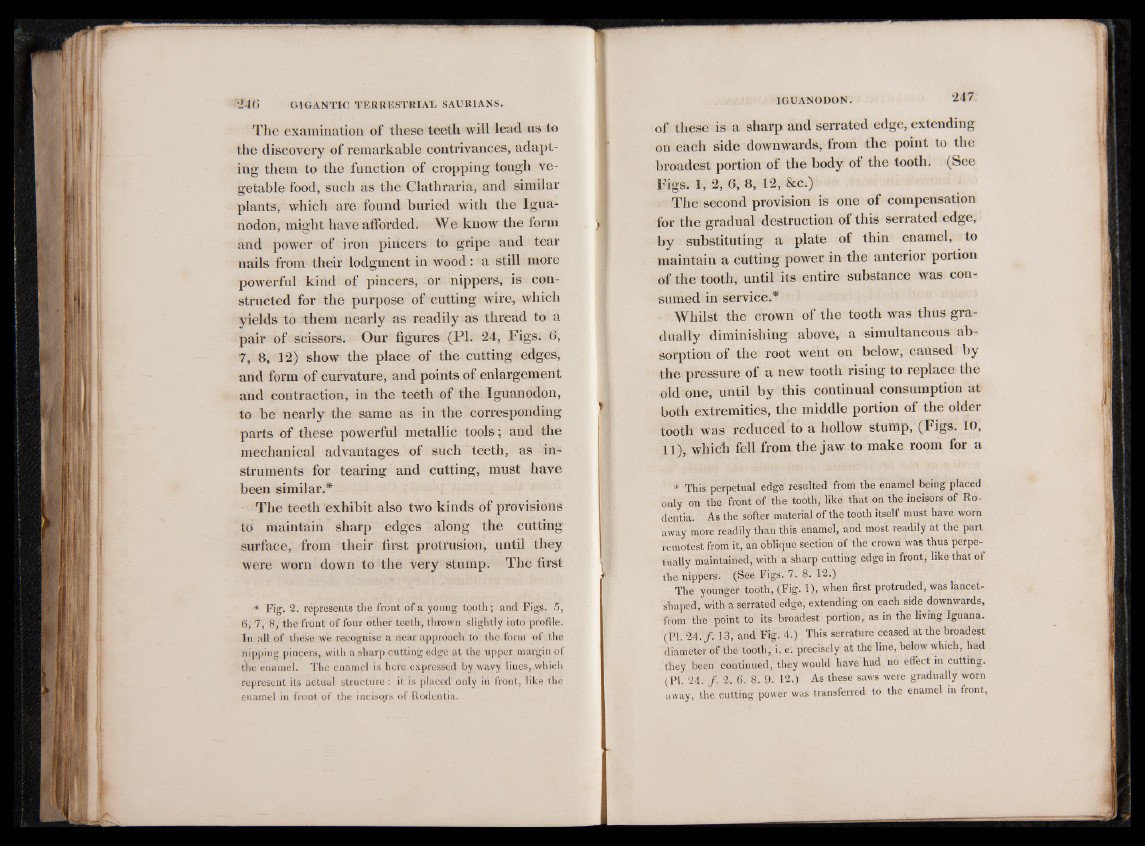
The examination of these teeth will lead us to
the discovery of remarkable contrivances, adapting
them to the function of cropping tough vegetable
food, such as the Clathraria, and similar
plants, which are found buried with the Iguanodon,
might have afforded. We know the form
and power of iron pincers to gripe and tear
nails from their lodgment in wood : a still more
powerful kind of pincers, or nippers, is constructed
for the purpose of cutting wire, which
yields to them nearly as readily as thread to a
pair of scissors. Our figures (PI. 24, Figs. 6,
7, 8, 12) show the place of the cutting edges,
and form of curvature, and points of enlargement
and contraction, in the teeth of the Iguanodon,
to be nearly the same as in the corresponding
parts of these powerful metallic tools; and the
mechanical advantages of such teeth, as instruments
for tearing and cutting, must have
been similar.*
The teeth exhibit also two kinds of provisions
to maintain sharp edges along the cutting
surface, from their first protrusion, until they
were worn down to the very stump. The first
* Fig. 2. represents the front of a young tooth ; and Figs. .5,
6, 7, 8, the front of four other teeth, thrown slightly into profile.
In all of these we recognise a near approach to the form of the
nipping pincers, with a sharp cutting edge at the upper margin of
the enamel. The enamel is here expressed by wavy lines, which
represent its actual structure : it is placed only in front, like the
enamel in front of the incisors of Rodentia.
of these is a sharp and serrated edge, extending
on each side downwards, from the point to the
broadest portion of the body of the tooth. (See
Figs. 1, 2, 6, 8, 12, &c.)
The second provision is one of compensation
for the gradual destruction of this serrated edge,
by substituting a plate of thin enamel, to
maintain a cutting power in the anterior portion
of the tooth, until its entire substance was consumed
in service.*
Whilst the crown of the tooth was thus gradually
diminishing above, a simultaneous absorption
of the root went on below, caused by
the pressure of a new tooth rising to replace the
old one, until by this continual consumption at
both extremities, the middle portion of the older
tooth was reduced to a hollow stump, (Figs. 10,
11), which fell from the jaw to make room for a
* This perpetual edge resulted from the enamel being placed
only on the front of the tooth, like that on the incisors of Rodentia.
As the softer material of the tooth itself must have worn
away more readily than this enamel, and most readily at the part
remotest from it, an oblique section of the crown was thus perpetually
maintained, with a sharp cutting edge in front, like that of
the nippers. (See Figs. 7. 8. 12.)
The younger tooth, (Fig. 1), when first protruded, was lancet-
shaped, with a serrated edge, extending on each side downwards,
from the point to its broadest portion, as in the living Iguana.
(PI. 24. ƒ. 13, and Fig. 4.) This serrature ceased at the broadest
diameter of the tooth, i. e. precisely at the line, below which, had
they been continued, they would have had no effect in cutting.
(PI. 24. ƒ. 2. 6. 8. 9. 12.) As these saws were gradually worn
away, the cutting power was transferred to the enamel in front,